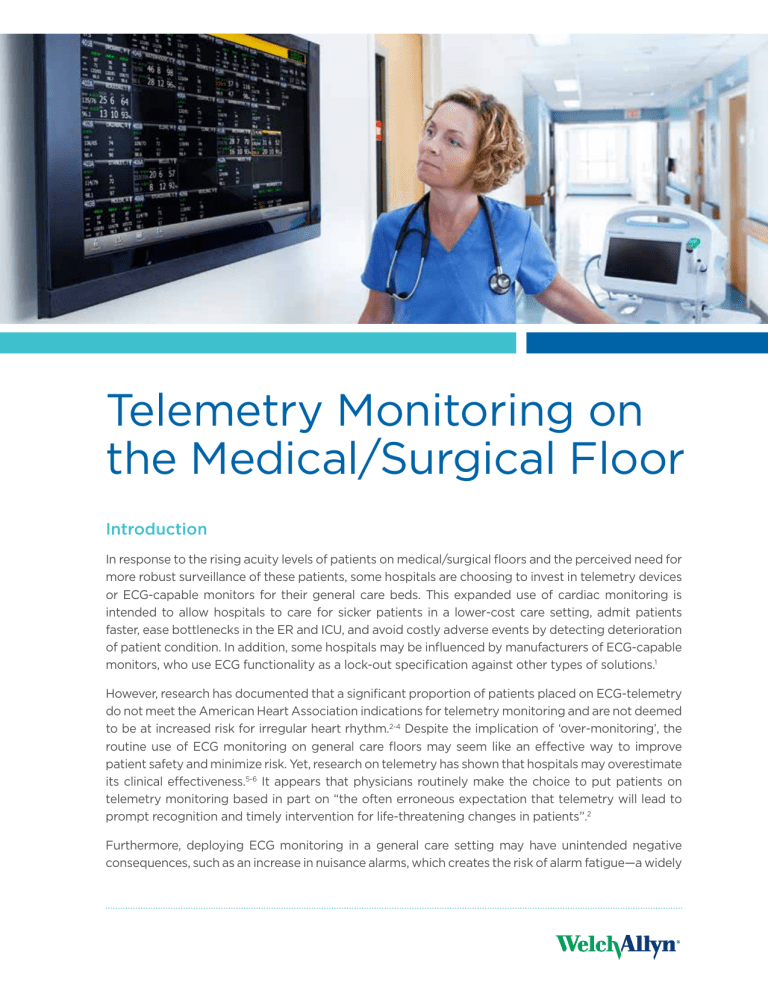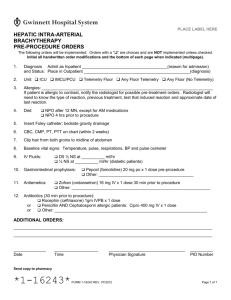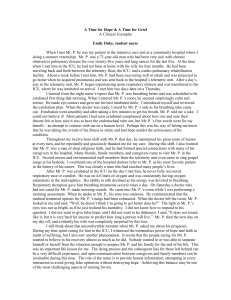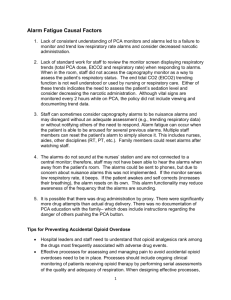Telemetry Monitoring on the Medical/Surgical Floor

Telemetry Monitoring on the Medical/Surgical Floor
Introduction
In response to the rising acuity levels of patients on medical/surgical floors and the perceived need for more robust surveillance of these patients, some hospitals are choosing to invest in telemetry devices or ECG-capable monitors for their general care beds. This expanded use of cardiac monitoring is intended to allow hospitals to care for sicker patients in a lower-cost care setting, admit patients faster, ease bottlenecks in the ER and ICU, and avoid costly adverse events by detecting deterioration of patient condition. In addition, some hospitals may be influenced by manufacturers of ECG-capable monitors, who use ECG functionality as a lock-out specification against other types of solutions.
1
However, research has documented that a significant proportion of patients placed on ECG-telemetry do not meet the American Heart Association indications for telemetry monitoring and are not deemed to be at increased risk for irregular heart rhythm.
2-4 Despite the implication of ‘over-monitoring’, the routine use of ECG monitoring on general care floors may seem like an effective way to improve patient safety and minimize risk. Yet, research on telemetry has shown that hospitals may overestimate its clinical effectiveness.
5-6 It appears that physicians routinely make the choice to put patients on telemetry monitoring based in part on “the often erroneous expectation that telemetry will lead to prompt recognition and timely intervention for life-threatening changes in patients”.
2
Furthermore, deploying ECG monitoring in a general care setting may have unintended negative consequences, such as an increase in nuisance alarms, which creates the risk of alarm fatigue—a widely
recognized risk to patient safety.
7 In light of the marginal clinical efficacy of ECG monitoring in the general care setting, its high incidence of nuisance alarms 8-13 , the added cost of floor-wide telemetry systems, and their more demanding workflow and staffing requirements, the utilization of telemetry for medical/surgical patient surveillance may be called into question.
Potential Problems with the Use of
Telemetry in General Care
that telemetry infrequently influences physician management decisions for patients at low risk, although it may in a relatively small subset at high risk”.
15 Studies of telemetry patients show that only a small fraction of patients have significant arrhythmias that lead to urgent intervention.
6 Thus, for those patients on the medical/surgical floor today, many of whom are at low risk according to the AHA guidelines, telemetry may not significantly influence care decisions.
A more effective strategy for surveillance of patients in the general care setting should focus on proper patient assessment, accomplished through regular vital signs and clinical observation. Expanded surveillance monitoring should be based on the existing care protocols and staff skill set found in general care areas today.
For patients who do eventually encounter cardiac events, it has been established that there are frequently clinical signs of deterioration hours before cardiac arrests or urgent transfers to the ICU.
16-18 The two most important predictors for patient adverse events have been shown to be Heart Rate/Pulse Rate (HR/PR) and Respiratory Rate (RR).
19 While ECG does measure continuous HR, there are other less complicated, less costly methods of monitoring HR/PR, for example, via pulse oximetry.
Clinical Effectiveness
Health care delivery organizations are more focused than ever on evaluating the efficacy of interventions and quantifying the link between quality of care and cost-effectiveness.
14 Hospitals want to ensure that any investments produce the desired clinical results.
However, in a literature review of the efficacy of cardiac monitoring, researchers at the Cleveland
Clinic concluded that “the available evidence suggests
Potential Consequences of
Telemetry Monitoring
For many patients on the medical/surgical floor today, it is respiratory failure that poses the most significant risk.
20 Data from a literature review on parameters that trigger rapid response team calls suggest respiratory dysfunctions, such as tachypnea, bradypnea, and desaturation, are the most common triggers for RRT activation.
21 Other studies find respiratory depression to be the most common reason for code blue events in patients receiving opioids 22 and one of the most common antecedents of in-hospital cardiac arrest.
18 For these patients at risk for respiratory complications, monitoring
Lack of early recognition of pulse oximetry (SpO ) and capnography
(etCO
2
) is an earlier indicator of respiratory
HIGHER ACUITY PATIENTS
ON MED/SURG FLOORS
OVER-ESTIMATION OF
CLINICAL EFFECTIVENESS
OF TELEMETRY
INCREASED USE
OF TELEMETRY
MONITORING ON
MED/SURG
False positiv es
Alarm fatigue training r equir ements
Ma chest wall impedance.
23 Furthermore,
ECG monitors derive a RR from changes in electrical impedance, which can be problematic due to artifacts and false alarms caused by patient movement and poor lead contact.
24 The RR measured via impedance pneumography has been shown to be less accurate than other methods, including capnography, manual measurements, and contact-free sur g sensing.
25-26
HIGHER ACUITY PATIENTS
ON MED/SURG FLOORS
OVER-ESTIMATION OF
CLINICAL EFFECTIVENESS
OF TELEMETRY
Early r ession respir atory depr
EXPANSION OF VITAL
SIGNS SURVEILLANCE
AND RESPIRATORY
MONITORING Fewer pa alarms/ tient alerts
Complements e med/ sur g w orkflo ting w
Although monitoring respiratory rate is a useful component of assessing patient status, the numeric reading provides only breaths per minute, not a measure of the quality of ventilation, which, in some patients is crucial. In patients whose airway becomes obstructed, respiratory rate is not a reliable monitor of ventilation, because episodes of obstruction are not usually associated with slow respiratory rates, and there is often chest movement without ventilation. Patients may experience profound hypoventilation due to shallow breathing while maintaining a respiratory rate within normal limits.
27
It is estimated that up to 99% of cardiac alarms do not require an intervention.
8-13 Causes of false alarms include setting the alarm thresholds “too tight,” default alarms not adjusted to individual patient needs, sensors that are not correctly applied, and patient movement.
24,30,31
Clinicians overwhelmed by the sheer multitude of beeps may disable or ignore alarms (known as alarm fatigue) sometimes with catastrophic results. The Boston Globe published a series of articles on the results of alarm
False Positives and Alarm
Fatigue
Alarm fatigue
Alarms disabled; under-utilization of
ST segment & QT monitoring features
Missed critical event
Increased morbidity
& mortality
Increased monitor alarms
(mostly false)
ADVERSE HOSPITAL OUTCOMES
One potential unintended consequence of the overuse of telemetry monitoring is the increased chance of artifacts being misinterpreted as abnormal rhythms, which could potentially lead to errors in patient care.
15 In fact, cases have been reported of patients undergoing unnecessary diagnostic or therapeutic procedures because of artifacts seen during telemetric monitoring.
Misdiagnosis of arrhythmia
Unnecessary diagnostic test
Inappropriate treatment rendered
Increased length of stay, resource use
Drew, BJ. Cardiac Monitoring Devices; Clinical Alarm Fatigue.
Presented at FDA Public Workshop on Study Methodology for
Diagnostics in the Post-Market Setting. May 12, 2011, Silver Spring, MD.
A second, potentially more dangerous consequence of the overuse of telemetry, especially on medical/surgical floors, is that of alarm fatigue.
Cardiovascular monitoring has been shown to be a significant driver of alarm events among the commonly monitored parameters. The following table summarizes alert rates documented in ICU settings: fatigue which reported that between January 2005 and
June 2010, 200 hospital patient deaths nationwide were linked to problems with alarms on patient monitors.
32-36
Clearly, deploying any monitoring technology will increase the quantity of patient alarms occurring on the medical/surgical floor. However, eliminating unnecessary ECG monitoring would significantly reduce false alarms and the alarm fatigue phenomenon.
Study Type of alerts
Alerts per
100 recording hours
Chambrin et al.,
1999 9
Gorges et al., 2009 29
Siebig et al., 2010 12
1. Ventilators (38%)
2. Cardiovascular monitors (37%)
3. Pulse oximeters (15%)
4. Capnography (14%)
1. Ventilators (40%)
2. Cardiovascular monitors (21%)
3. Pulse oximeters (15%)
4. Infusion pumps (12%)
1. Cardiovascular monitors (66%)
2. Pulse oximeters (26%)
3. Respiration rate (3%)
161
636
604
Workflow and Staffing Implications
In addition to clinical efficacy, there are several important factors to consider when contemplating the deployment of telemetry monitoring into a general care environment—an environment where challenges around cost constraints, staff skill sets and workload, patient and staff satisfaction and risk mitigation abound.
A typical deployment for telemetry systems is to have patient data monitored in a centralized ‘war room’ outside of the floor. In this scenario, nurses at the bedside do not have actionable patient data at their fingertips. For example, they would be unable to effectively monitor patient status when administering drugs or performing other interventions. Alternatively, the telemetry data could be sent to a central station at the floor’s nursing station. While this would improve access to accurate patient data, many of these ECGbased central stations were designed for the ICU, not for the medical/surgical floor or for use by non-CCRN trained nurses.
24 hours.
15 Whatever the true cost, inappropriate use of telemetry on patients who may not materially benefit from it can create an unnecessary financial burden on the health care system and an unnecessary cost for patients.
Alternative Solutions to Telemetry
Should Be Considered
While the risk of adverse events on the medical/surgical floor is very real, the foregoing problems suggest that deploying telemetry monitoring throughout a hospital’s general care areas may not be the most effective means
ECG monitoring requires interpretation of waveforms and recognition of waveform artifacts, and most nurses in medical/surgical units are not trained in this skill. Therefore, effective use of ECG monitoring would require either training the nursing staff on ECG interpretation or employing a monitoring technician at each central station.
Regardless of where the monitoring will be done, the floor nurses would be charged with managing the ECG lead preparation and placement, which can national staffing standards for medical/ for the early recognition of those changes in vital signs that precede most adverse events. In fact, the possibility of the unintended consequences of improper treatment and alarm fatigue due to false positive alarms may lead to compromised patient safety. Furthermore, telemetry is a costly system that requires a specialized skill set not generally found in medical/surgical settings and that may negatively impact clinical workflow.
Lack of early recognition of respiratory depression
Potential Benefits of Vital Signs
False Positives
Employing traditional cardiac monitoring technologies
Training Requirements and workflows on medical/surgical floors is often es tantamount to converting them to step-down floors or
Cost be challenging, especially if done for every patient. medical/surgical nurses could be problematic in light of the high patient-to-nurse ratios found in general care settings. For this reason, intermediate care—essentially critical care with higher patient-to-nurse ratios. The medical/surgical floor
MONITORING ON
MED/SURG
Alarm fatigue training r equir ements surgical units with telemetry monitoring
Surveillance
are higher than those of unmonitored medical/surgical units. For example, in
California, the nurse-to-patient ratio for telemetry patients is 1:4, while for
‘unmonitored’ medical/surgical beds, it is
1:5.
37
HIGHER ACUITY PATIENTS
ON MED/SURG FLOORS
Ma sur g
Early r ession respir atory depr
Cost
OVER-ESTIMATION OF
CLINICAL EFFECTIVENESS
OF TELEMETRY
EXPANSION OF VITAL
SIGNS SURVEILLANCE
AND RESPIRATORY
MONITORING Fewer pa alarms/ tient alerts
Telemetry requires specialized equipment and trained personnel, making it both costly and labor-intensive. Researchers at the Cleveland Clinic estimate that the cost of telemetric monitoring in their hospital is at least $1,400 per patient per
Complements e med/ sur g w orkflo ting w
therefore may be better served by utilizing the vital signs monitoring technology and workflows presently in use, rather than deploying traditional continuous cardiac monitoring to perform patient surveillance for early detection of deterioration. This alternative approach focuses efforts on patient assessment, regular vital signs observations, and the ability to continuously monitor PR, RR, quality of ventilation and oxygenation with the same devices which general care nurses are already confident and competent using for their vital signs protocols.
on the medical/surgical floor. For example, EarlySense® contact-free monitoring uses an under-mattress sensor to monitor PR, RR and motion levels to help nursing staff detect patient deterioration so they can intervene to help patients avoid falls and pressure ulcers. One study assessed the effects of using EarlySense to continuously monitor HR and RR in a medical/surgical unit, and found a significant decrease in total length of stay, in ICU days for transferred patients, and in code blue rates.
46
It has been shown that changes in a patient’s oxygenation and respiration can reliably provide early indication of respiratory depression.
38,39 For this reason, and as a reaction to the increasing risk of respiratory failure in the general care setting, patient safety organizations recommend the continuous assessment of oxygenation and ventilation, via pulse oximetry (SpO
2
) and capnography (etCO
2
), to reduce the incidence of respiratory failure in patients receiving opioids post-operatively.
40-42
Unlike traditional telemetry monitoring, this type of contact-free continuous monitoring has been shown to produce a much smaller volume of patient alerts, particularly false alarms. Data from the same study showed that the EarlySense System generated about
2 alerts per nurse per 12-hour shift. Another study reported that 100% of major events and 88.6% of all events of deterioration, which occurred on sub-acute units in three hospitals, were detected by EarlySense, with only 1 false alarm per 80 hours of monitoring (3.4 days).
47
Fortunately, this type of continuous monitoring can be readily incorporated into care protocols on a medical/ surgical floor.
SpO
2
, PR and RR parameters are already familiar to general care nurses. These parameters also tend to generate fewer patient alarms than do cardiac monitoring (see Table 1), and, thanks to innovative alarm management algorithms, industry leaders
Covidien® and Masimo® have documented significant reductions in false alarms compared with older pulse oximetry technology.
43-44 While the use of capnography in medical/surgical care settings is still growing, and can be new to some, there are technologies and algorithms available which ease its adoption and use. For example,
Covidien Microstream® capnography provides the
Integrated Pulmonary Index™, a single 1-to-10 value that represents a real-time respiratory profile based on etCO
2
, RR, PR and SpO
2
, and provides a comprehensive indication of respiratory status and trends.
45
Summary
It appears that, in some hospitals, ECG/telemetry monitoring has been the default approach for surveillance of patients that fall between the ICU and the medical/surgical setting on the care continuum, even though they may not meet the indications for telemetry or truly benefit from arrhythmia monitoring.
This approach may lead to unintended clinical outcomes, including missed events due to alarm fatigue, and has very real implications for clinical workflow and staffing on medical/surgical floors. Fortunately, an alternative approach designed specifically for general care floors exists: one of emphasizing patient assessment, regular vital signs observations, and the ability to monitor
(pulse rate, respiration rate, quality of ventilation and oxygenation) with the same devices general care nurses are already confident and competent using for their vital signs protocols.
There are other, newer, monitoring technologies available which provide early recognition of patient deterioration, and are designed specifically for the patient population, nursing skill set and clinical workflow
References
1 Kowalczyk, L. Wide heart monitor use tied to missed alarms. http://www.boston.com/lifestyle/health/articles/2011/12/29/burgeoning_heart_monitor_use_tied_to_ missed_alarms/?page=1 December 29, 2011. Accessed February 20, 2014.
2 Kanwar M, Fares R, Minnick S, et al. Inpatient Cardiac Telemetry Monitoring: Are We Overdoing It? JCOM 2008; 15(1): 16-20.
3 Funk M, Winkler CG, May JL et al. Unnecessary arrhythmia monitoring and underutilization of ischemia and QT interval monitoring in current clinical practice: baseline results of the Practical Use of the Latest Standards for Electrocardiography trial. Journal of Electrocardiology 2010;43(6): 542-547.
4 Drew BJ, Califf RM, Funk M, et al. Practice standards for electrocardiographic monitoring in hospital settings: an American Heart Association scientific statement from the Councils on Cardiovascular Nursing, Clinical Cardiology, and Cardiovascular Disease in the Young: endorsed by the International Society of Computerized
Electrocardiology and the American Association of Critical-Care Nurses. Circulation 2004; 110:2721–2746.
5 Pelczarski KM, Barbell AS. Making tough decisions about telemetry monitoring. Hosp Mater Manage Q 1993;15:1–12.
6 Estrada CA, Rosman HS, Prasad NK, et al. Role of telemetry monitoring in the non-intensive care unit. Am J Cardiol 1995;76:960–5.
7 ECRI Institute. Top 10 Health Technology Hazards. Available at: https://www.ecri.org/Forms/Pages/ECRI-Institute-2013-Top-10-Hazards.aspx.
8 Atzema C, Schull MJ, Borgundvaag B, Slaughter GR, Lee CK. ALARMED: adverse events in low-risk patients with chest pain receiving continuous electrocardiographic monitoring in the emergency department. A pilot study. Am J Emerg Med. 2006;24(1):62-67.
9 Chambrin MC, Ravaux P, Calvelo-Aros D, Jaborska A, Chopin C, Boniface B. Multicentric study of monitoring alarms in the adult intensive care unit (ICU): a descriptive analysis. Intensive Care Med. 1999;25(12):1360-1366.
10 Lawless ST. Crying wolf: false alarms in a pediatric intensive care unit. Crit Care Med. 1994;22(6):981-985.
11 O’Carroll TM. Survey of alarms in an intensive therapy unit. Anaesthesia. 1986;41(7):742-744.
12 Siebig S, Kuhls S, Imhoff M, Gather U, Schölmerich J, Wrede CE. Intensive care unit alarms—how many do we need? Crit Care Med. 2010;38(2):451-456.
13 Tsien CL, Fackler JC. Poor prognosis for existing monitors in the intensive care unit. Crit Care Med. 1997;25(4):614-619.
14 Curry JP, Hanson CW 3rd, Russell MW, et al. The use and effectiveness of electrocardiographic telemetry monitoring in a community hospital general care setting.
Anesth Analg 2003; 97:1483–7.
15 Henriques-Forsythe MN, Ivonye CC, Jamched U, et al. Is telemetry overused? Is it as helpful as thought? Cleveland Clinic Journal of Medicine 2009; 76(6): 368-372.
16 Buist et al. Recognising clinical instability in hospital patients before cardiac arrest or unplanned admission to intensive care. A pilot study in a tertiary-care hospital.
Med J Aust. 1999 Jul 5;171(1):22-5.
17 Kause et al. A comparison of antecedents to cardiac arrests, deaths and emergency intensive care admissions in Australia and New Zealand, and the United
Kingdom--the ACADEMIA study. Resuscitation. 2004 Sep;62(3):275-82.
18 Schein RM, Hazday N, Pena M, Ruben BH, Sprung CL: Clinical antecedents to in-hospital cardiopulmonary arrest. Chest 1990; 98: 1388-92
19 Chaboyer, W et al, Am J Crit Care. 2008;17: 255-263
20 HealthGrades Patient Safety in American Hospitals Study, 2011
21 Alian A, Rafferty T. Evaluation of rapid response team flag-alert parameters. STA Annual Meeting Abstracts, 2009: 7. Available at: http://www.anestech.org/media/
Publications/Annual_2009/2009_STA_Abstracts.pdf.
22 Fecho K, Joyner L, Pfeiffer D. Opioids and code blue emergencies. Anesthesiology 2008;109:A34.
23 Weinger MB, Lee LA. No Patient Shall Be Harmed By Opioid-Induced Respiratory Depression. Proceedings of “Essential Monitoring Strategies to Detect Clinically
Significant Drug-Induced Respiratory Depression in the Postoperative Period” Conference. APSF Newsletter Fall 2011; 26(2): 21-40. (Table 1)
24 Schmid et al. Patient monitoring alarms in the ICU and in the operating room. Critical Care 2013; 17(216):1-7.
25 Ben-Ari J, Zimlichman E, Adi N, Sorkine P. Contactless respiratory and heart rate monitoring: validation of an innovative tool. Journal of Medical Engineering and
Technology. 2010; Early Online, 1-6.
26 Goucher A, Frasca D, Mimoz O, Debaene B. Accuracy of respiratory rate monitoring by capnometry using the Capnomask® in extubated patients receiving supplemental oxygen after surgery. British Journal of Anaesthesia. 2012; 108(2): 316-20.
27 Stoelting Robert and Simon Hillier. Pharmacology and Physiology in Anesthetic Practice. 4th ed. Lippincott Williams & Wilkins; 2005 (Pg92 Chap 3 section 1).
28 Knight BP, Pelosi F, Michaud GF, Strickberger SA, Morady F. Clinical consequences of electrocardiographic artifact mimicking ventricular tachycardia. N Engl J Med
1999; 341:1270–1274.
29 Görges M, Markewitz B, Westenskow D. Improving alarm performance in the medical intensive care unit using delays and clinical context. Anesth Analg.
2009;108:1546-1552.
30 Graham KC, Cvach M. Monitor alarm fatigue: standardizing use of physiological monitors and decreasing nuisance alarms. Am J Crit Care. 2010;19(1):28-35.
31 The Joint Commission. Medical device alarm safety in hospitals. Sentinel Event Alert. April 8, 2013; issue 50.
32 Available at: http://www.jointcommission.org/assets/1/18/SEA_50_alarms_4_5_13_FINAL1.PDF.
33 Kowalczyk L. No easy solutions for alarm fatigue. Boston Globe. February 11, 2011. Available at: http://www.boston.com/lifestyle/health/articles/2011/02/14/no_easy_ solutions_for_alarm_fatigue/?page=full.
34 Kowalczyk L. Patient alarms often unheard, unheeded. Boston Globe. February 13, 2011. Available at: http://www.boston.com/lifestyle/health/articles/2011/02/13/ patient_alarms_often_unheard_unheeded/.
35 Kowalczyk L. For nurses, it’s a constant dash to respond to alarms. Boston Globe. February 13, 2011. Available at: http://www.boston.com/lifestyle/health/articles/2011/02/13/for_nurses_its_a_constant_dash_to_respond_to_alarms/.
36 Kowalczyk L. Ventilator errors are linked to 119 deaths. Boston Globe. December 11, 2011. Available at: http://www.boston.com/news/local/massachusetts/ articles/2011/12/11/ventilator_errors_are_linked_to_119_deaths/.
37 Kowalczyk L. Alarm fatigue a factor in second death. Boston Globe. September 21, 2011. Available at: http://www.boston.com/lifestyle/health/articles/2011/09/21/ umass_hospital_has_second_death_involving_alarm_fatigue/.
38 California RN Staffing Ratio Law. February 10, 2004. 2004-R-0212.
39 Hutchison R, Rodriguez L. Capnography and Respiratory Depression. American Journal of Nursing. 2008; 108(2): 35-39.
40 McCarter T, Shaik Z, Scarfo K, Thompson LJ. Capnography Monitoring Enhances Safety of Postoperative Patient-Controlled Analgesia. American Health & Drug
Benefits. 2008; 1(5): 28-35.
41 The Joint Commission. (August 8 2012). Safe Use of Opioids in Hospitals. Sentinel Event Alert, 49.
42 Stoelting, R.K. and Overdyk, F.J. (2011, June 8). Anesthesia Patient Safety Foundation. Essential Monitoring Strategies to Detect Clinically Significant Drug-Induced
Respiratory Depression in the Postoperative Period.
43 Top 10 Health Technology Hazards, 2011: Oversedation During Use of PCA Infusion Pumps
44 Comparison of capnography derived respiratory rate alarm frequency using the SARA algorithm versus an established non-adaptive respiratory rate alarm management algorithm in bariatric surgical patients. Hockman S, Glembot T, Niebel K. 2009 Open Forum Abstracts, Respiratory Care, December 2009. http://www.smartcapnography.net/articles/comparison.php
45 Shah N, Ragaswamy HB, Govindugari K, Estanol L. Performance of Three New-Generation Pulse Oximeters during Motion and Low Perfusion in Volunteers. J Clin
Anesth. 2012;24(5):385-91. http://www.covidien.com/rms/products/capnography/capnostream-20p-bedside-patient-monitor
46 Brown H, Terrence J, Vasquez P, et al. Continuous Monitoring in an Inpatient Medical-Surgical Unit: A Controlled Clinical Trial. The American Journal of Medicine.
2014;127(3):226-232.
47 Zimlichman E, Levkovitch S, Argaman D. Evaluation of EverOn™ as a Tool to Detect Deteriorations in Medical/Surgical Patients. White Paper. Available at: http://www.earlysense.com/wp-content/uploads/2013/08/White_Paper_Early_Detec_Deter_Oct29-09.pdf
© 2014 Welch Allyn MC11587






